Analysis of AASB Conceptual Framework: A Cleanaway Waste Report
VerifiedAdded on 2023/06/12
|20
|2915
|84
Report
AI Summary
This report provides a thorough analysis of Cleanaway Waste Management Limited's compliance with the Australian Accounting Standards Board (AASB) conceptual framework, along with Corporations Act 2001, IASB and IFRS standards. The report examines the company's adherence to AASB objectives related to financial position, performance, and changes in financial position, demonstrating how Cleanaway's consolidated balance sheet, income statement, and cash flow statements align with these objectives. Furthermore, it assesses the company's recognition criteria for assets, liabilities, equity, revenue, and expenses, highlighting specific accounting treatments and their compliance with relevant AASB standards. The report also evaluates the presence of fundamental (relevance and faithful representation) and enhancing (comparability, verifiability, timeliness, and understandability) qualitative characteristics in Cleanaway's financial reporting, concluding that the company demonstrates strong adherence to AASB principles and standards in its financial practices.
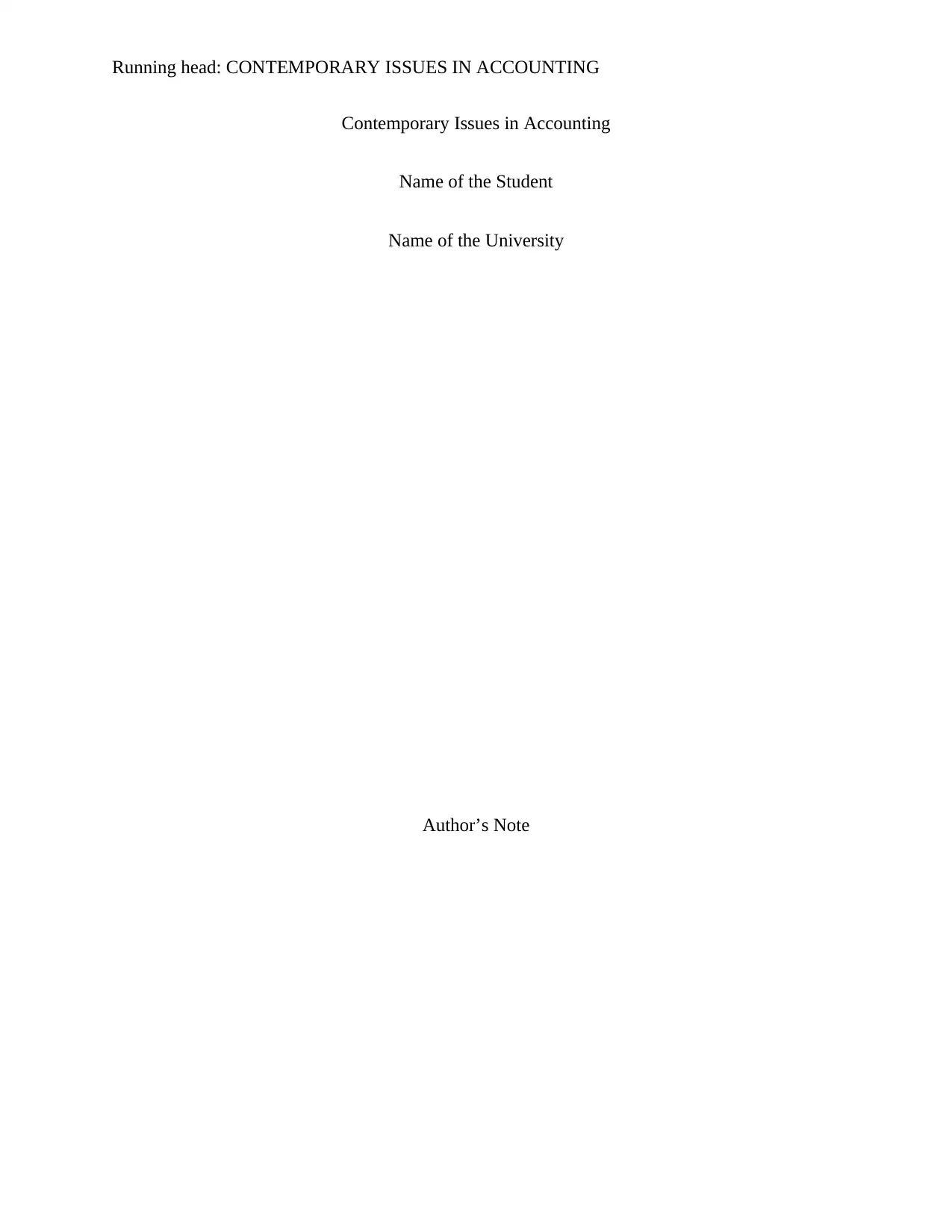
Running head: CONTEMPORARY ISSUES IN ACCOUNTING
Contemporary Issues in Accounting
Name of the Student
Name of the University
Author’s Note
Contemporary Issues in Accounting
Name of the Student
Name of the University
Author’s Note
Paraphrase This Document
Need a fresh take? Get an instant paraphrase of this document with our AI Paraphraser
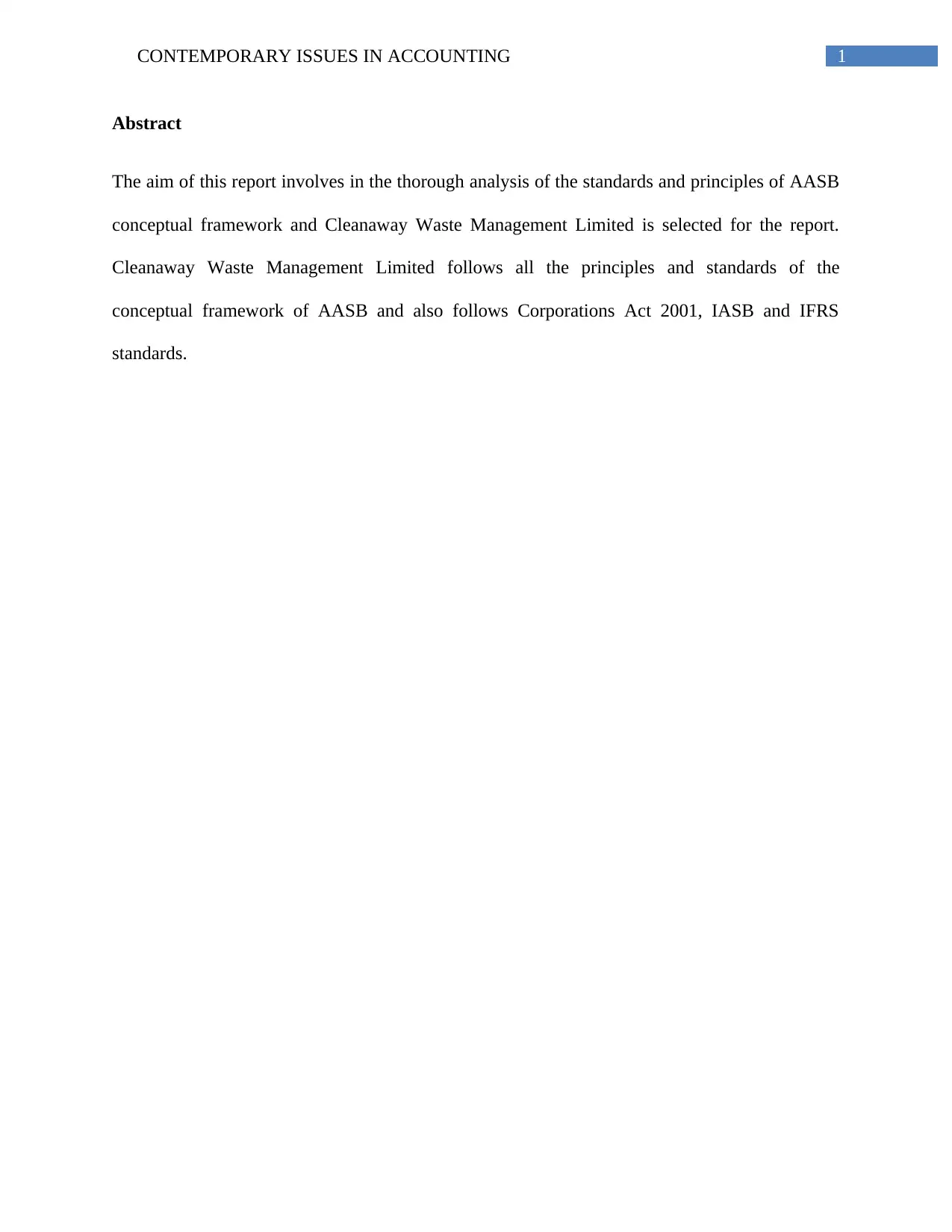
1CONTEMPORARY ISSUES IN ACCOUNTING
Abstract
The aim of this report involves in the thorough analysis of the standards and principles of AASB
conceptual framework and Cleanaway Waste Management Limited is selected for the report.
Cleanaway Waste Management Limited follows all the principles and standards of the
conceptual framework of AASB and also follows Corporations Act 2001, IASB and IFRS
standards.
Abstract
The aim of this report involves in the thorough analysis of the standards and principles of AASB
conceptual framework and Cleanaway Waste Management Limited is selected for the report.
Cleanaway Waste Management Limited follows all the principles and standards of the
conceptual framework of AASB and also follows Corporations Act 2001, IASB and IFRS
standards.
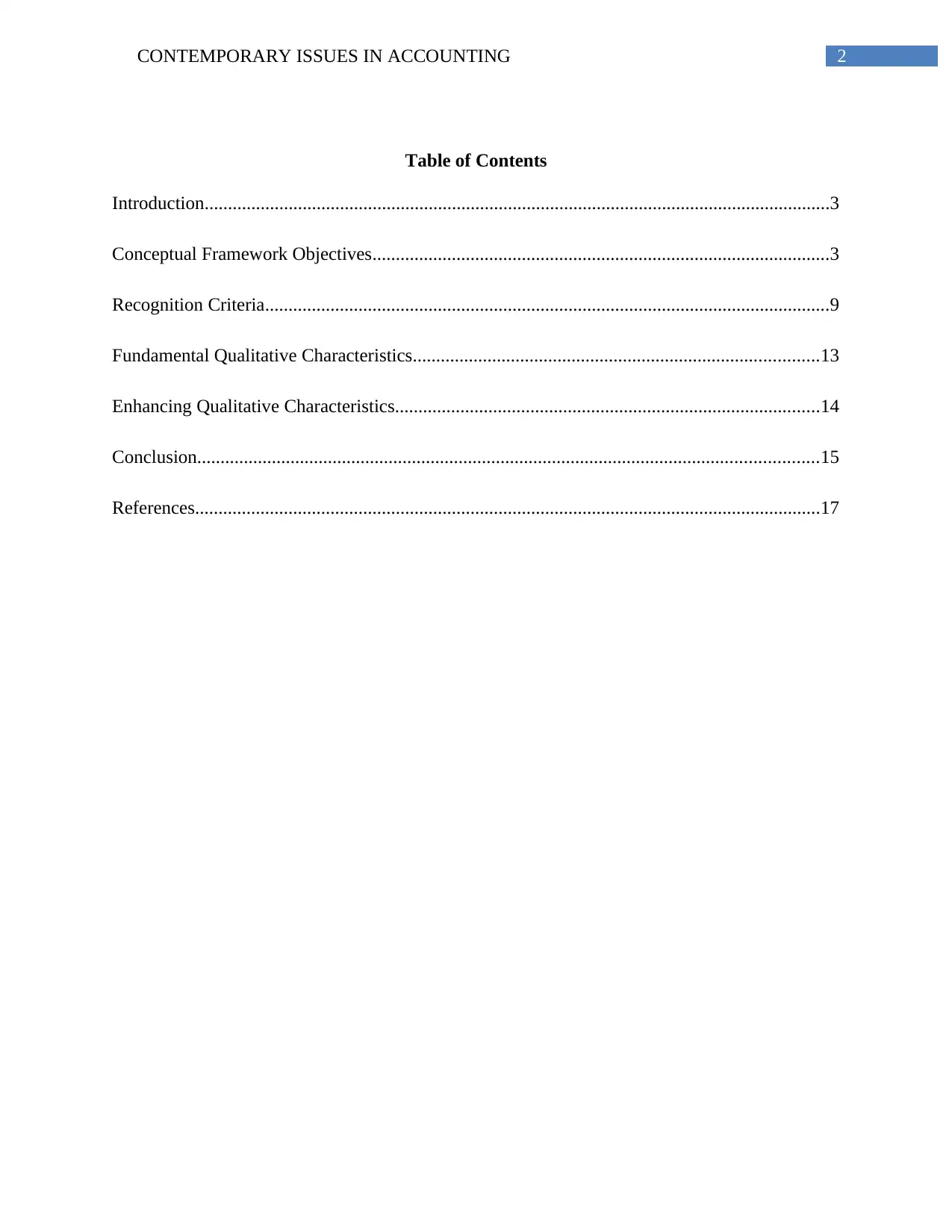
2CONTEMPORARY ISSUES IN ACCOUNTING
Table of Contents
Introduction......................................................................................................................................3
Conceptual Framework Objectives..................................................................................................3
Recognition Criteria.........................................................................................................................9
Fundamental Qualitative Characteristics.......................................................................................13
Enhancing Qualitative Characteristics...........................................................................................14
Conclusion.....................................................................................................................................15
References......................................................................................................................................17
Table of Contents
Introduction......................................................................................................................................3
Conceptual Framework Objectives..................................................................................................3
Recognition Criteria.........................................................................................................................9
Fundamental Qualitative Characteristics.......................................................................................13
Enhancing Qualitative Characteristics...........................................................................................14
Conclusion.....................................................................................................................................15
References......................................................................................................................................17
⊘ This is a preview!⊘
Do you want full access?
Subscribe today to unlock all pages.

Trusted by 1+ million students worldwide
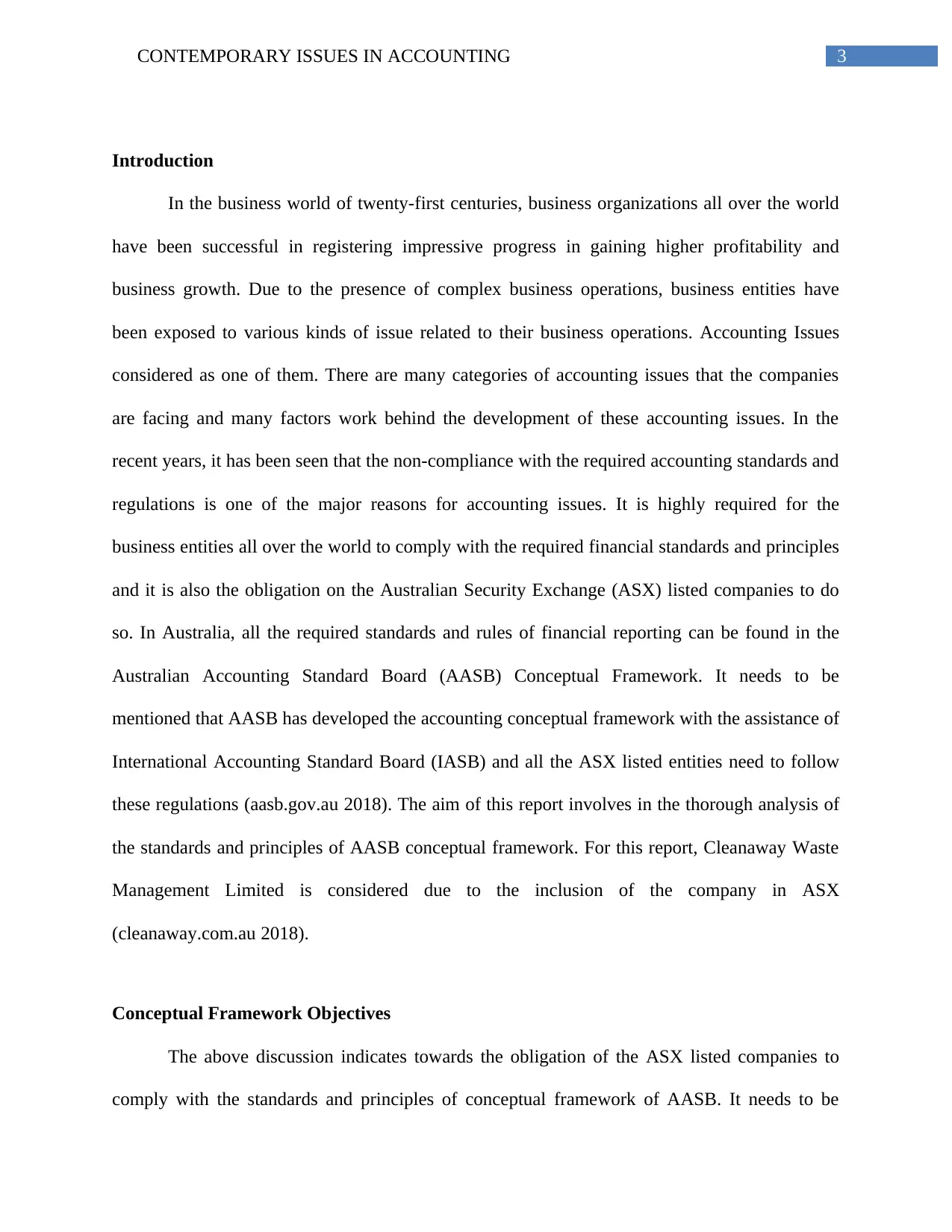
3CONTEMPORARY ISSUES IN ACCOUNTING
Introduction
In the business world of twenty-first centuries, business organizations all over the world
have been successful in registering impressive progress in gaining higher profitability and
business growth. Due to the presence of complex business operations, business entities have
been exposed to various kinds of issue related to their business operations. Accounting Issues
considered as one of them. There are many categories of accounting issues that the companies
are facing and many factors work behind the development of these accounting issues. In the
recent years, it has been seen that the non-compliance with the required accounting standards and
regulations is one of the major reasons for accounting issues. It is highly required for the
business entities all over the world to comply with the required financial standards and principles
and it is also the obligation on the Australian Security Exchange (ASX) listed companies to do
so. In Australia, all the required standards and rules of financial reporting can be found in the
Australian Accounting Standard Board (AASB) Conceptual Framework. It needs to be
mentioned that AASB has developed the accounting conceptual framework with the assistance of
International Accounting Standard Board (IASB) and all the ASX listed entities need to follow
these regulations (aasb.gov.au 2018). The aim of this report involves in the thorough analysis of
the standards and principles of AASB conceptual framework. For this report, Cleanaway Waste
Management Limited is considered due to the inclusion of the company in ASX
(cleanaway.com.au 2018).
Conceptual Framework Objectives
The above discussion indicates towards the obligation of the ASX listed companies to
comply with the standards and principles of conceptual framework of AASB. It needs to be
Introduction
In the business world of twenty-first centuries, business organizations all over the world
have been successful in registering impressive progress in gaining higher profitability and
business growth. Due to the presence of complex business operations, business entities have
been exposed to various kinds of issue related to their business operations. Accounting Issues
considered as one of them. There are many categories of accounting issues that the companies
are facing and many factors work behind the development of these accounting issues. In the
recent years, it has been seen that the non-compliance with the required accounting standards and
regulations is one of the major reasons for accounting issues. It is highly required for the
business entities all over the world to comply with the required financial standards and principles
and it is also the obligation on the Australian Security Exchange (ASX) listed companies to do
so. In Australia, all the required standards and rules of financial reporting can be found in the
Australian Accounting Standard Board (AASB) Conceptual Framework. It needs to be
mentioned that AASB has developed the accounting conceptual framework with the assistance of
International Accounting Standard Board (IASB) and all the ASX listed entities need to follow
these regulations (aasb.gov.au 2018). The aim of this report involves in the thorough analysis of
the standards and principles of AASB conceptual framework. For this report, Cleanaway Waste
Management Limited is considered due to the inclusion of the company in ASX
(cleanaway.com.au 2018).
Conceptual Framework Objectives
The above discussion indicates towards the obligation of the ASX listed companies to
comply with the standards and principles of conceptual framework of AASB. It needs to be
Paraphrase This Document
Need a fresh take? Get an instant paraphrase of this document with our AI Paraphraser
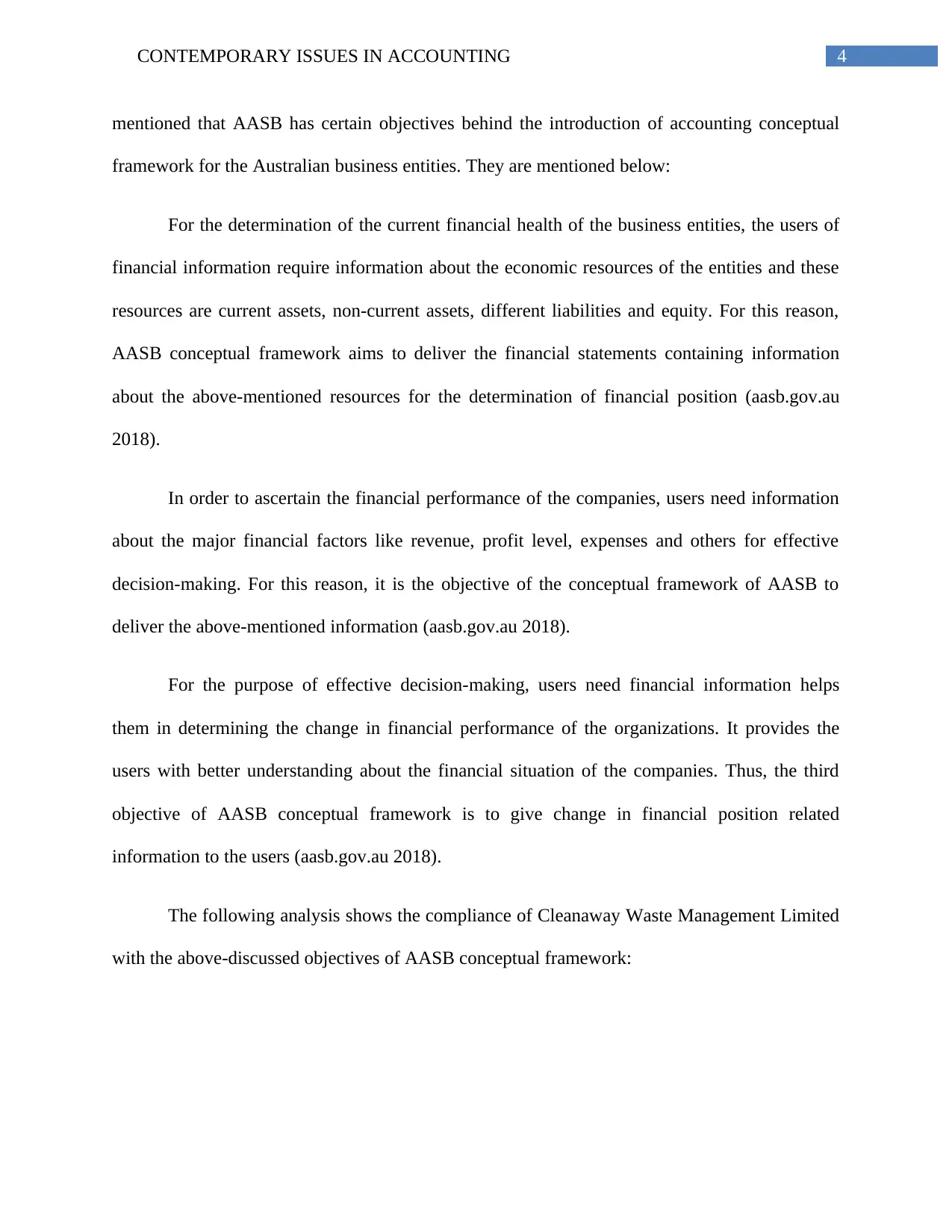
4CONTEMPORARY ISSUES IN ACCOUNTING
mentioned that AASB has certain objectives behind the introduction of accounting conceptual
framework for the Australian business entities. They are mentioned below:
For the determination of the current financial health of the business entities, the users of
financial information require information about the economic resources of the entities and these
resources are current assets, non-current assets, different liabilities and equity. For this reason,
AASB conceptual framework aims to deliver the financial statements containing information
about the above-mentioned resources for the determination of financial position (aasb.gov.au
2018).
In order to ascertain the financial performance of the companies, users need information
about the major financial factors like revenue, profit level, expenses and others for effective
decision-making. For this reason, it is the objective of the conceptual framework of AASB to
deliver the above-mentioned information (aasb.gov.au 2018).
For the purpose of effective decision-making, users need financial information helps
them in determining the change in financial performance of the organizations. It provides the
users with better understanding about the financial situation of the companies. Thus, the third
objective of AASB conceptual framework is to give change in financial position related
information to the users (aasb.gov.au 2018).
The following analysis shows the compliance of Cleanaway Waste Management Limited
with the above-discussed objectives of AASB conceptual framework:
mentioned that AASB has certain objectives behind the introduction of accounting conceptual
framework for the Australian business entities. They are mentioned below:
For the determination of the current financial health of the business entities, the users of
financial information require information about the economic resources of the entities and these
resources are current assets, non-current assets, different liabilities and equity. For this reason,
AASB conceptual framework aims to deliver the financial statements containing information
about the above-mentioned resources for the determination of financial position (aasb.gov.au
2018).
In order to ascertain the financial performance of the companies, users need information
about the major financial factors like revenue, profit level, expenses and others for effective
decision-making. For this reason, it is the objective of the conceptual framework of AASB to
deliver the above-mentioned information (aasb.gov.au 2018).
For the purpose of effective decision-making, users need financial information helps
them in determining the change in financial performance of the organizations. It provides the
users with better understanding about the financial situation of the companies. Thus, the third
objective of AASB conceptual framework is to give change in financial position related
information to the users (aasb.gov.au 2018).
The following analysis shows the compliance of Cleanaway Waste Management Limited
with the above-discussed objectives of AASB conceptual framework:
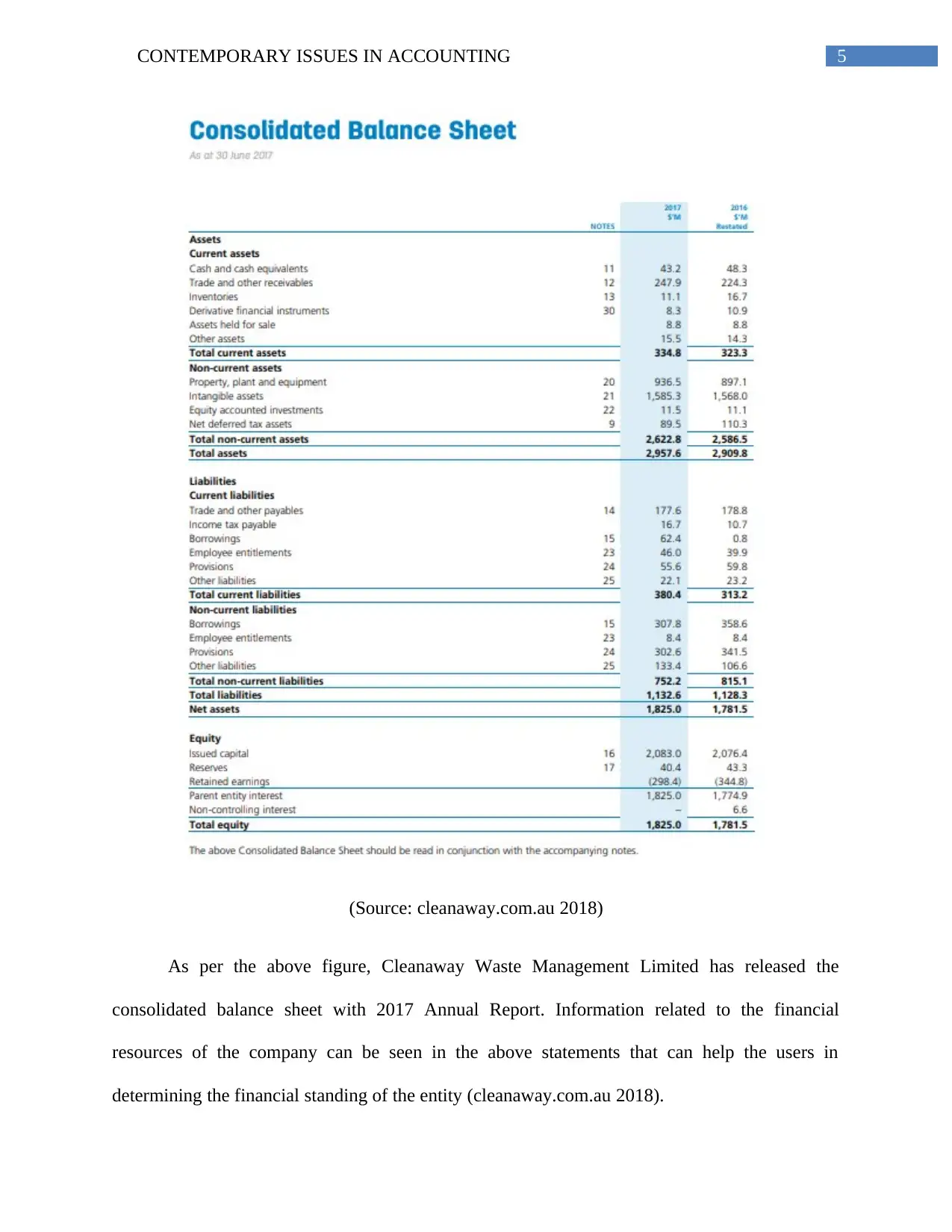
5CONTEMPORARY ISSUES IN ACCOUNTING
(Source: cleanaway.com.au 2018)
As per the above figure, Cleanaway Waste Management Limited has released the
consolidated balance sheet with 2017 Annual Report. Information related to the financial
resources of the company can be seen in the above statements that can help the users in
determining the financial standing of the entity (cleanaway.com.au 2018).
(Source: cleanaway.com.au 2018)
As per the above figure, Cleanaway Waste Management Limited has released the
consolidated balance sheet with 2017 Annual Report. Information related to the financial
resources of the company can be seen in the above statements that can help the users in
determining the financial standing of the entity (cleanaway.com.au 2018).
⊘ This is a preview!⊘
Do you want full access?
Subscribe today to unlock all pages.

Trusted by 1+ million students worldwide
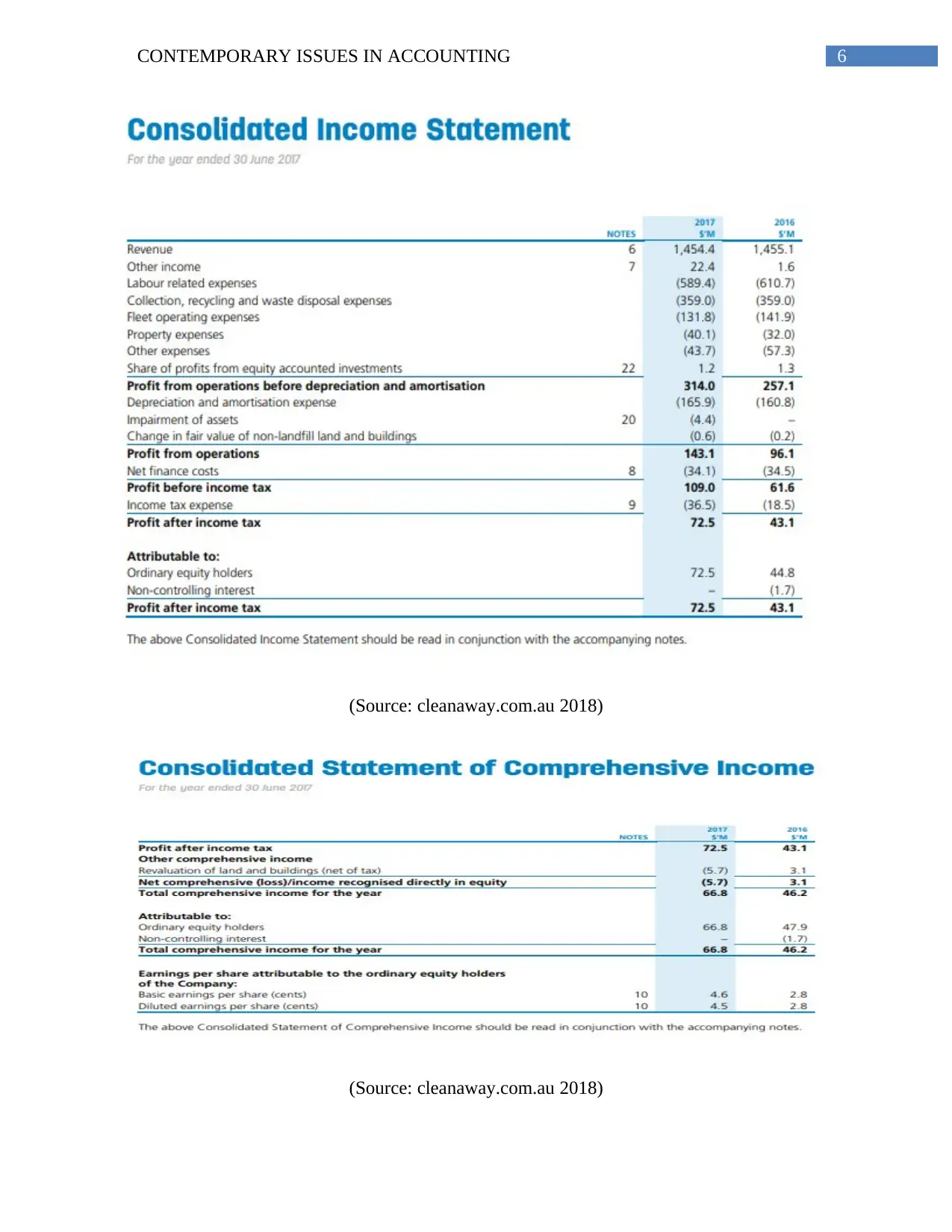
6CONTEMPORARY ISSUES IN ACCOUNTING
(Source: cleanaway.com.au 2018)
(Source: cleanaway.com.au 2018)
(Source: cleanaway.com.au 2018)
(Source: cleanaway.com.au 2018)
Paraphrase This Document
Need a fresh take? Get an instant paraphrase of this document with our AI Paraphraser
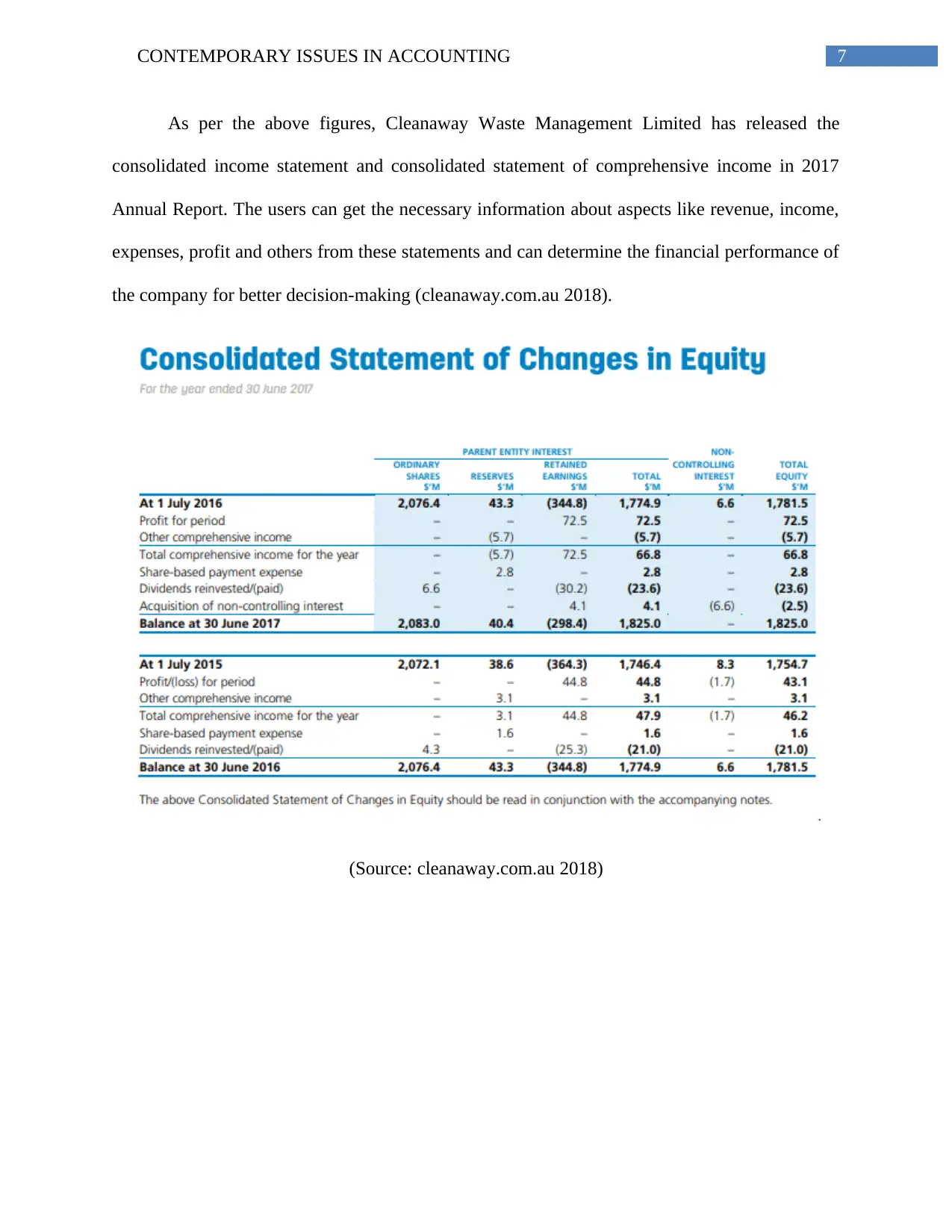
7CONTEMPORARY ISSUES IN ACCOUNTING
As per the above figures, Cleanaway Waste Management Limited has released the
consolidated income statement and consolidated statement of comprehensive income in 2017
Annual Report. The users can get the necessary information about aspects like revenue, income,
expenses, profit and others from these statements and can determine the financial performance of
the company for better decision-making (cleanaway.com.au 2018).
(Source: cleanaway.com.au 2018)
As per the above figures, Cleanaway Waste Management Limited has released the
consolidated income statement and consolidated statement of comprehensive income in 2017
Annual Report. The users can get the necessary information about aspects like revenue, income,
expenses, profit and others from these statements and can determine the financial performance of
the company for better decision-making (cleanaway.com.au 2018).
(Source: cleanaway.com.au 2018)
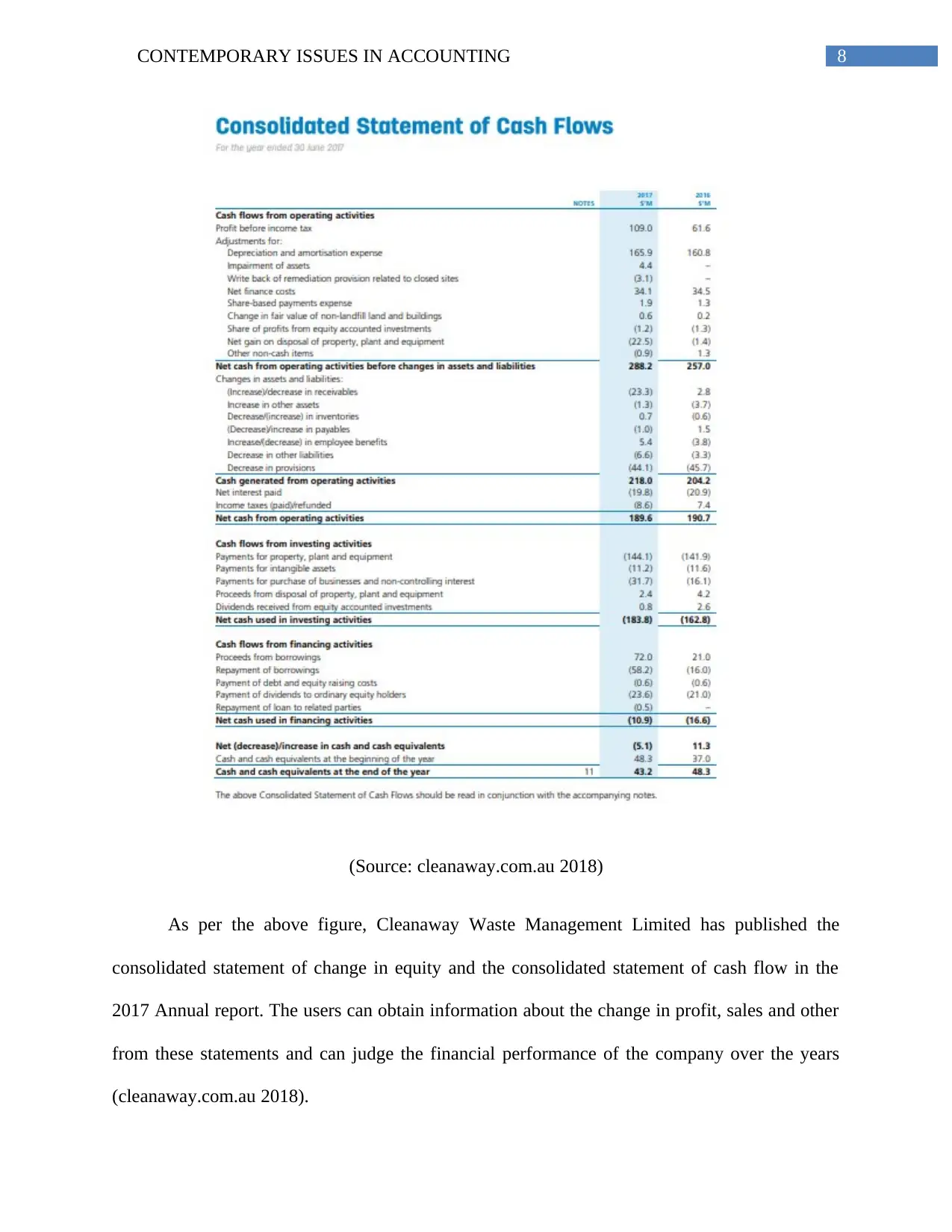
8CONTEMPORARY ISSUES IN ACCOUNTING
(Source: cleanaway.com.au 2018)
As per the above figure, Cleanaway Waste Management Limited has published the
consolidated statement of change in equity and the consolidated statement of cash flow in the
2017 Annual report. The users can obtain information about the change in profit, sales and other
from these statements and can judge the financial performance of the company over the years
(cleanaway.com.au 2018).
(Source: cleanaway.com.au 2018)
As per the above figure, Cleanaway Waste Management Limited has published the
consolidated statement of change in equity and the consolidated statement of cash flow in the
2017 Annual report. The users can obtain information about the change in profit, sales and other
from these statements and can judge the financial performance of the company over the years
(cleanaway.com.au 2018).
⊘ This is a preview!⊘
Do you want full access?
Subscribe today to unlock all pages.

Trusted by 1+ million students worldwide
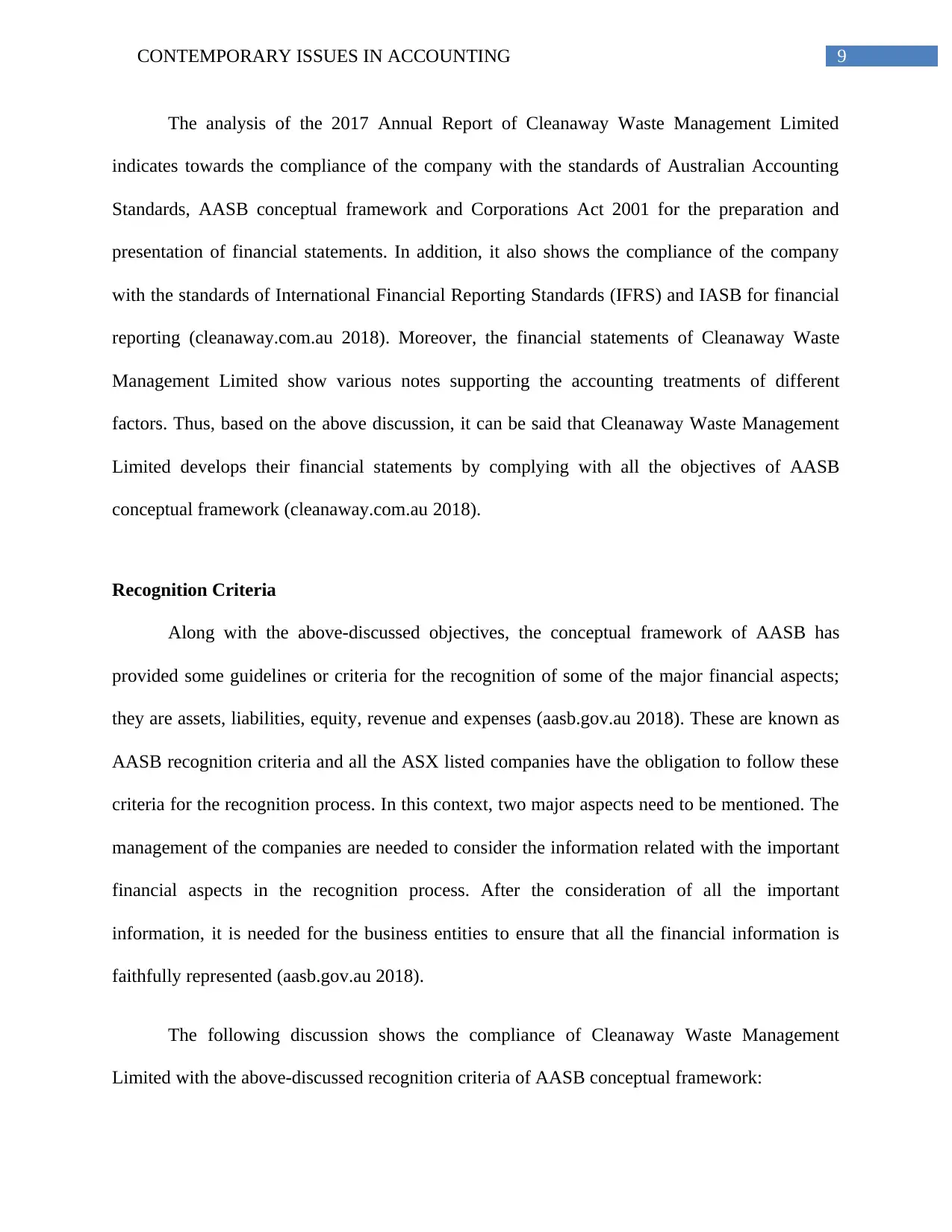
9CONTEMPORARY ISSUES IN ACCOUNTING
The analysis of the 2017 Annual Report of Cleanaway Waste Management Limited
indicates towards the compliance of the company with the standards of Australian Accounting
Standards, AASB conceptual framework and Corporations Act 2001 for the preparation and
presentation of financial statements. In addition, it also shows the compliance of the company
with the standards of International Financial Reporting Standards (IFRS) and IASB for financial
reporting (cleanaway.com.au 2018). Moreover, the financial statements of Cleanaway Waste
Management Limited show various notes supporting the accounting treatments of different
factors. Thus, based on the above discussion, it can be said that Cleanaway Waste Management
Limited develops their financial statements by complying with all the objectives of AASB
conceptual framework (cleanaway.com.au 2018).
Recognition Criteria
Along with the above-discussed objectives, the conceptual framework of AASB has
provided some guidelines or criteria for the recognition of some of the major financial aspects;
they are assets, liabilities, equity, revenue and expenses (aasb.gov.au 2018). These are known as
AASB recognition criteria and all the ASX listed companies have the obligation to follow these
criteria for the recognition process. In this context, two major aspects need to be mentioned. The
management of the companies are needed to consider the information related with the important
financial aspects in the recognition process. After the consideration of all the important
information, it is needed for the business entities to ensure that all the financial information is
faithfully represented (aasb.gov.au 2018).
The following discussion shows the compliance of Cleanaway Waste Management
Limited with the above-discussed recognition criteria of AASB conceptual framework:
The analysis of the 2017 Annual Report of Cleanaway Waste Management Limited
indicates towards the compliance of the company with the standards of Australian Accounting
Standards, AASB conceptual framework and Corporations Act 2001 for the preparation and
presentation of financial statements. In addition, it also shows the compliance of the company
with the standards of International Financial Reporting Standards (IFRS) and IASB for financial
reporting (cleanaway.com.au 2018). Moreover, the financial statements of Cleanaway Waste
Management Limited show various notes supporting the accounting treatments of different
factors. Thus, based on the above discussion, it can be said that Cleanaway Waste Management
Limited develops their financial statements by complying with all the objectives of AASB
conceptual framework (cleanaway.com.au 2018).
Recognition Criteria
Along with the above-discussed objectives, the conceptual framework of AASB has
provided some guidelines or criteria for the recognition of some of the major financial aspects;
they are assets, liabilities, equity, revenue and expenses (aasb.gov.au 2018). These are known as
AASB recognition criteria and all the ASX listed companies have the obligation to follow these
criteria for the recognition process. In this context, two major aspects need to be mentioned. The
management of the companies are needed to consider the information related with the important
financial aspects in the recognition process. After the consideration of all the important
information, it is needed for the business entities to ensure that all the financial information is
faithfully represented (aasb.gov.au 2018).
The following discussion shows the compliance of Cleanaway Waste Management
Limited with the above-discussed recognition criteria of AASB conceptual framework:
Paraphrase This Document
Need a fresh take? Get an instant paraphrase of this document with our AI Paraphraser
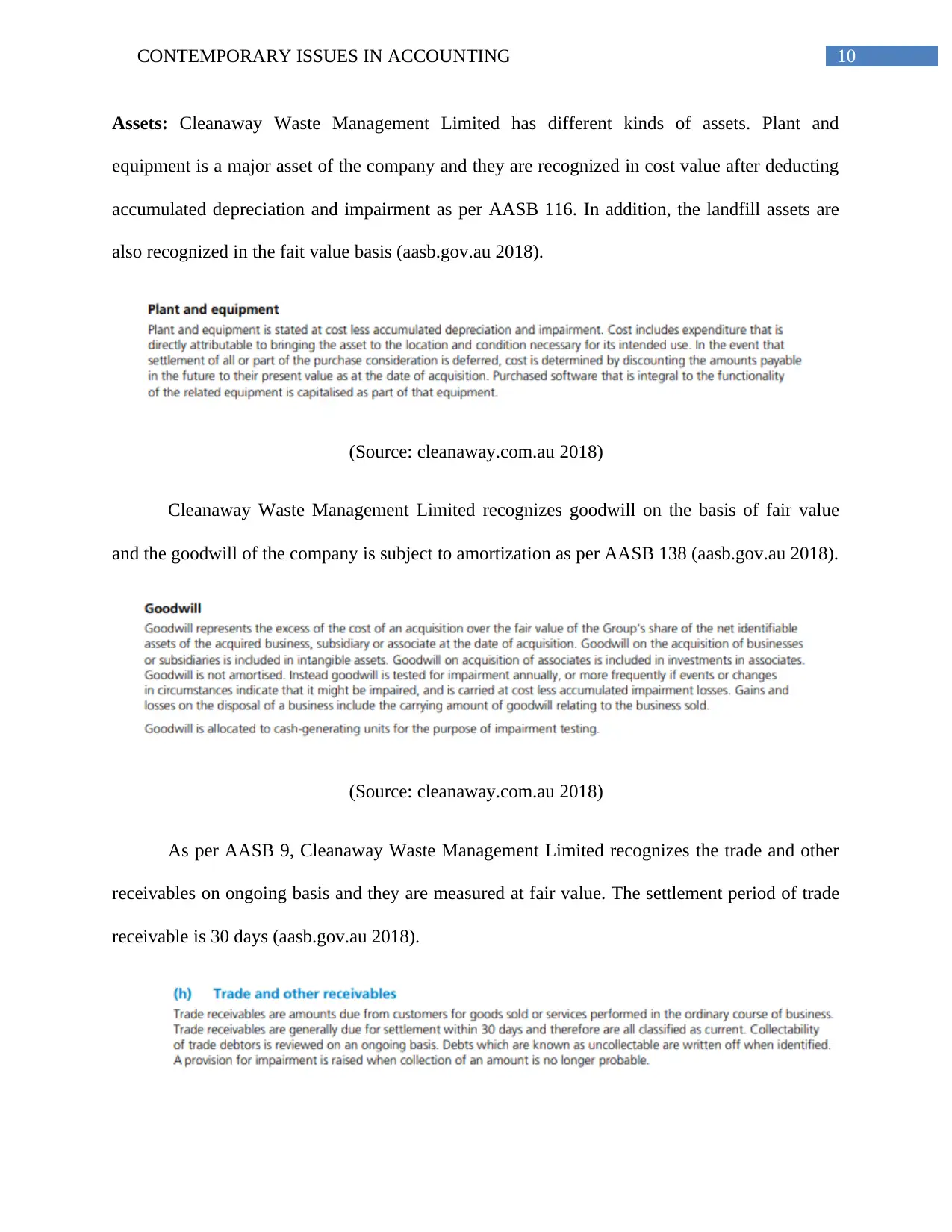
10CONTEMPORARY ISSUES IN ACCOUNTING
Assets: Cleanaway Waste Management Limited has different kinds of assets. Plant and
equipment is a major asset of the company and they are recognized in cost value after deducting
accumulated depreciation and impairment as per AASB 116. In addition, the landfill assets are
also recognized in the fait value basis (aasb.gov.au 2018).
(Source: cleanaway.com.au 2018)
Cleanaway Waste Management Limited recognizes goodwill on the basis of fair value
and the goodwill of the company is subject to amortization as per AASB 138 (aasb.gov.au 2018).
(Source: cleanaway.com.au 2018)
As per AASB 9, Cleanaway Waste Management Limited recognizes the trade and other
receivables on ongoing basis and they are measured at fair value. The settlement period of trade
receivable is 30 days (aasb.gov.au 2018).
Assets: Cleanaway Waste Management Limited has different kinds of assets. Plant and
equipment is a major asset of the company and they are recognized in cost value after deducting
accumulated depreciation and impairment as per AASB 116. In addition, the landfill assets are
also recognized in the fait value basis (aasb.gov.au 2018).
(Source: cleanaway.com.au 2018)
Cleanaway Waste Management Limited recognizes goodwill on the basis of fair value
and the goodwill of the company is subject to amortization as per AASB 138 (aasb.gov.au 2018).
(Source: cleanaway.com.au 2018)
As per AASB 9, Cleanaway Waste Management Limited recognizes the trade and other
receivables on ongoing basis and they are measured at fair value. The settlement period of trade
receivable is 30 days (aasb.gov.au 2018).
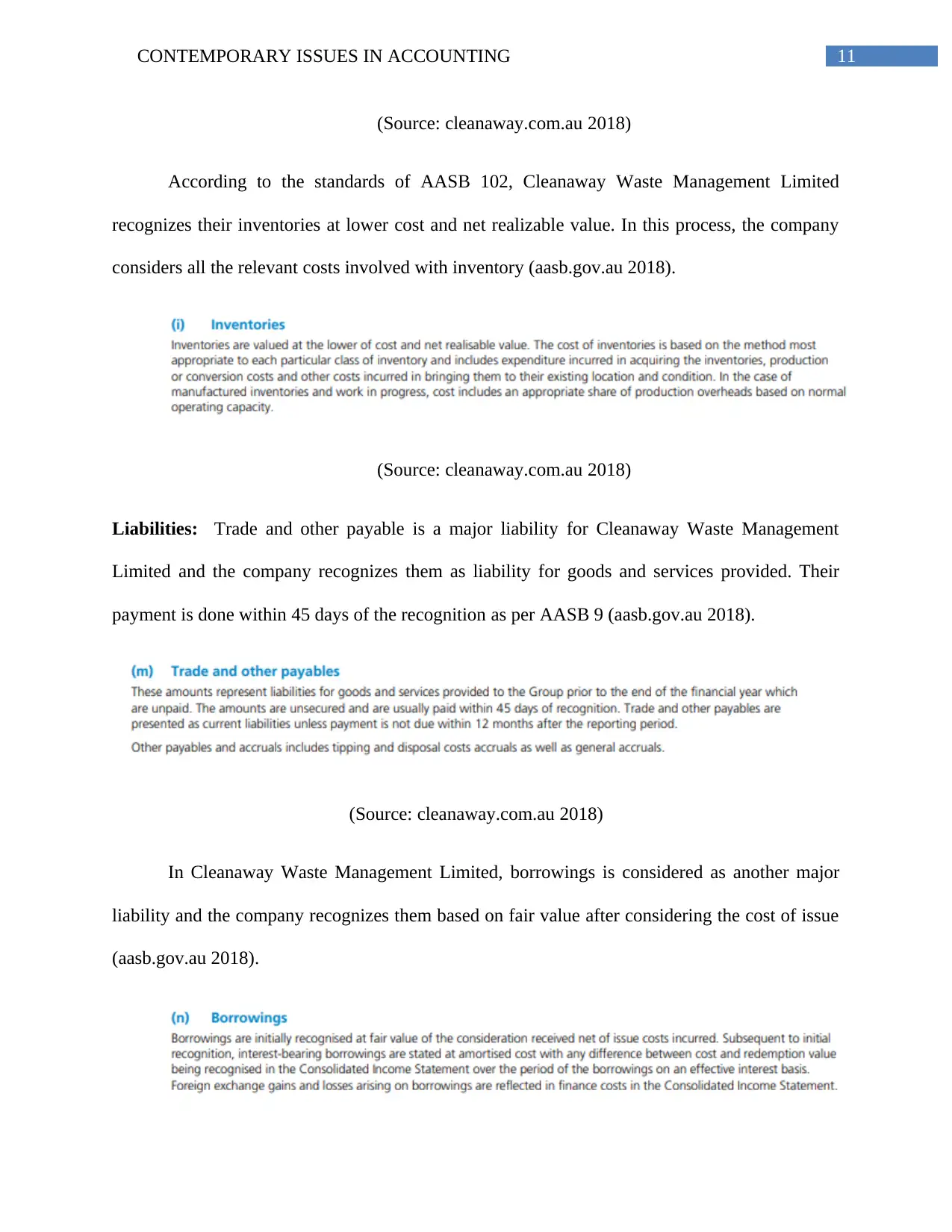
11CONTEMPORARY ISSUES IN ACCOUNTING
(Source: cleanaway.com.au 2018)
According to the standards of AASB 102, Cleanaway Waste Management Limited
recognizes their inventories at lower cost and net realizable value. In this process, the company
considers all the relevant costs involved with inventory (aasb.gov.au 2018).
(Source: cleanaway.com.au 2018)
Liabilities: Trade and other payable is a major liability for Cleanaway Waste Management
Limited and the company recognizes them as liability for goods and services provided. Their
payment is done within 45 days of the recognition as per AASB 9 (aasb.gov.au 2018).
(Source: cleanaway.com.au 2018)
In Cleanaway Waste Management Limited, borrowings is considered as another major
liability and the company recognizes them based on fair value after considering the cost of issue
(aasb.gov.au 2018).
(Source: cleanaway.com.au 2018)
According to the standards of AASB 102, Cleanaway Waste Management Limited
recognizes their inventories at lower cost and net realizable value. In this process, the company
considers all the relevant costs involved with inventory (aasb.gov.au 2018).
(Source: cleanaway.com.au 2018)
Liabilities: Trade and other payable is a major liability for Cleanaway Waste Management
Limited and the company recognizes them as liability for goods and services provided. Their
payment is done within 45 days of the recognition as per AASB 9 (aasb.gov.au 2018).
(Source: cleanaway.com.au 2018)
In Cleanaway Waste Management Limited, borrowings is considered as another major
liability and the company recognizes them based on fair value after considering the cost of issue
(aasb.gov.au 2018).
⊘ This is a preview!⊘
Do you want full access?
Subscribe today to unlock all pages.

Trusted by 1+ million students worldwide
1 out of 20
Related Documents
Your All-in-One AI-Powered Toolkit for Academic Success.
+13062052269
info@desklib.com
Available 24*7 on WhatsApp / Email
![[object Object]](/_next/static/media/star-bottom.7253800d.svg)
Unlock your academic potential
Copyright © 2020–2025 A2Z Services. All Rights Reserved. Developed and managed by ZUCOL.




